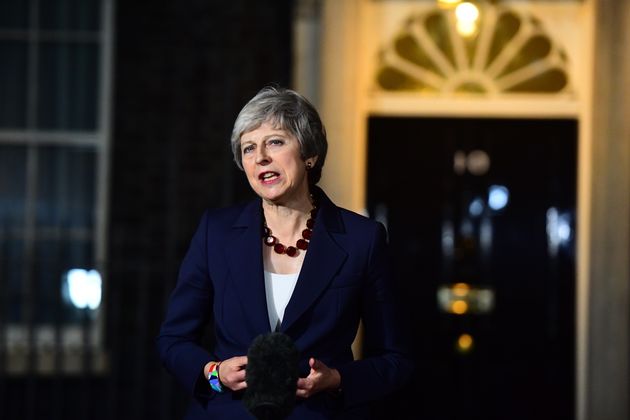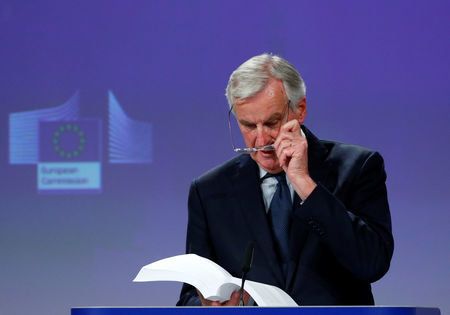
Theresa May has announced the Cabinet has agreed to back her Brexit deal following a five-hour emergency meeting.
In a statement on the steps of Downing Street on Wednesday evening, the Prime Minister told reporters that frontbenchers had taken “a collective decision” to support her divorce bill following an “impassioned debate”.
“I firmly believe that the draft withdrawal agreement was the best that could be negotiated and it was for the Cabinet to decide whether to move on in the talks,” she said.
“The choices before us were difficult, particularly in relation to the Northern Ireland backstop, but the collective decision of Cabinet was that the government should agree the draft withdrawal agreement and the outline political declaration.”
Her statement came immediately following the lengthy meeting of senior ministers, which began shortly after May urged MPs in the Commons to back her agreement, which she said would bring the UK “significantly closer” to delivering the result of the 2016 referendum.
The PM said the Cabinet’s decision was a “decisive step which enables us to move on and finalise the deal in the days ahead”.
“These decisions were not taken lightly, but I believe it is a decision that is firmly in the national interest,” she added.
“When you strip away the detail the choice before us is clear – this deal which delivers on the vote of the referendum, which brings back control of our money, laws and borders, ends free movement, protects jobs, security and our Union, or leave with no deal or no Brexit at all.”
Tensions were heightened throughout the day on Wednesday by reports that senior Brussels negotiator Sabine Weyand had told ambassadors the deal will mean the UK aligns its rules with Europe, while the EU “will retain all the controls”.
But Weyand – deputy to chief EU negotiator Michel Barnier – cast doubt on the veracity of a leaked note containing her supposed comments by “liking” a series of tweets which said it was “not an accurate reflection of the EU’s position”.

On Thursday morning, European Council president Donald Tusk gave his verdict on the deal, saying Brexit was a “lose-lose situation” for the UK and EU and sending a message to the British people.
“As much as I am sad to see you leave, I will do everything to make this farewell the least painful possible, for you and for us,” he said.
Tusk also confirmed that the EU will hold an extraordinary summit in Brussels on 25 November, to rubber-stamp the deal.
Following May’s statement, Barnier said the draft agreement was a result of “very intense negotiations” and represented a “crucial step” in the process.
He told a press conference in Brussels: “I know that the path is still long and may well be difficult to guarantee an orderly withdrawal, and beyond the orderly withdrawal, to build something.”
But the chief negotiator avoided answering directly a question on whether the draft agreement was a “take it or leave it” deal.
On the Northern Ireland backstop, he said if there was no final agreement at the end of the transition in December 2020 they would create an “EU-UK single customs territory”.
“Northern Ireland will therefore remain in this same customs territory as the rest of the UK,” he told reporters.
“In addition Northern Ireland will remain aligned to those rules of the single market that are essential for avoiding a hard border.
“The UK would apply the EU’s customs code in Northern Ireland. It would allow Northern Irish businesses to bring goods in the single market without restrictions which is essential to avoid a hard border.”
The PM will make a further statement in the Commons on Thursday morning, where she said she fully expects the agreement to come under “intense scrutiny” from MPs.
“It is my job as prime minister to explain the decision government has taken and I stand ready to do that,” she said outside No.10.
But even after convincing her Cabinet to support the deal, May’s chances of winning a Commons vote currently appear slim, with a sense of unease spreading across the green benches and some reported “reservations” from several frontbenchers remaining.
Jeremy Corbyn is expected to order Labour MPs to vote against it. Speaking during PMQs, he blasted the deal as the “worst of all worlds” that was a “failure in its own terms”.
The Northern Irish DUP, which props up May’s minority government, on Wednesday said it would vote against the deal.
The Tory Brexiteer European Research Group (ERG) of MPs has claimed an “irreducible core” of 40 members are also certain to vote against the PM and its chair Jacob Rees-Mogg said they should not support the deal.
“The proposed agreement will see the UK hand over £39bn to the EU for little or nothing in return,” he said in a letter to members.
The ardent Leave supporter said the draft agreement was “unacceptable to unionists”, will “lock us into an EU customs union and EU laws” and is “profoundly undemocratic”.
He added: “For these reasons I can not support the proposed agreement in Parliament and would hope that Conservative MPs would do likewise.
All 13 Scottish Conservative MPs – including Scotland Secretary David Mundell – signed a joint letter on Wednesday warning May that they could not support a deal which failed to restore “complete control and full sovereignty” over the UK’s fishing waters.
The conservative Bow Group think tank also called on the PM to stand down on Wednesday evening, claiming she is unable to deliver on Brexit.
In a statement, it said: “David Cameron left office on the basis that the Brexit result needed a Brexiteer leader and a Brexit government to implement the referendum campaign promises.
“We instead got a Remain-supporting leader and a Cabinet staffed by 70% Remain supporters.
“Theresa May has demonstrated with her final deal that she has been unable to implement what the British people voted for in Brexit, it is therefore time for her to stand aside.”